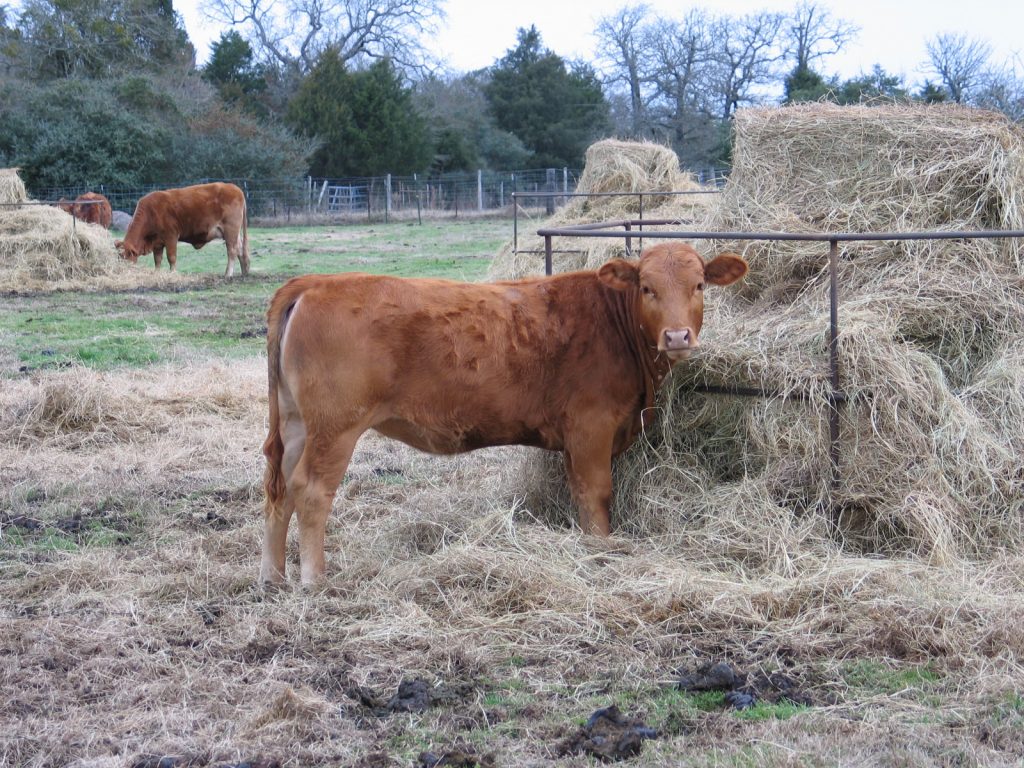Probiotic curbs nitrate poisoning, also lessens methane emissions

Image: Texas A&M AgriLife
Two government researchers and a college graduate student aiming at one issue in the cattle industry are finding they can address two issues – nitrite poisoning and methane emissions – with an animal probiotic they are developing.
The new probiotic is now on its way to commercialization.
The science behind the patent-pending technology, developed by Texas A&M AgriLife Research and the U.S. Department of Agriculture Agricultural Research Service (USDA-ARS), occurred over a seven-year period.
Stress from the drought of 2011 caused high nitrate levels in millions of tons of forages and hays, elevating the risk to cattle, because their rumen converts nitrate into poisonous nitrite during digestion.
Longtime collaborators Bill Pinchak, AgriLife Research beef nutritionist in Vernon, and Robin Anderson, microbiologist with USDA-ARS in College Station, initiated research to combat the poisoning.
Elizabeth Latham joined the research in 2013 as a Texas A&M University doctoral student under both Pinchak and Anderson. She was pursuing a research program in the microbiome in relationship to animals.
“The initial project they put me on was only supposed to last a few months,” Latham said. “After three years, the excitement of what was possible kept me working on the same project. Seven years and many research papers later, we’re ready to move out of the research phase and into the commercialization phase.”
She is now lead scientist with Bezoar Laboratories LLC in Bryan, a company she formed, and is carrying the research to the marketplace to address not only nitrite poisoning, but methane gas production.
Their product, a bacteria-based probiotic, is expected to increase feed efficiency, decrease the carriage of pathogens and reduce methane emissions.
Pinchak said nitrate poisoning from forage and hay is regularly occurring – in years when the occurrence is high, producers just don’t use the feed or they mix it with a low nitrate forage to slowly acclimate the animals to the high nitrate feed.
Their initial research sought to find a hypernitrate- and hypernitrite-metabolizing bacteria to be fed as a probiotic to decrease risk of poisoning in animals eating high nitrate feed.
Anderson explained nitrate and nitrite are two different chemicals – nitrate is commonly found in some plants, usually at low levels, and is not particularly toxic to cattle. But when plants accumulate high levels of nitrate in response to heat or drought stress, the microbes in the rumen of animals eating those forages convert the nitrate into a more toxic form, nitrite.
“There are also naturally occurring microbes that can take nitrite and detoxify it into ammonia or nitrogen gas,” he said. “However, that process is much slower. So if the animal is not acclimated, the first process takes place faster than the second and the animal becomes sick.”
A number of probiotics currently available have a limited shelf life because they are live bacteria, Pinchak said. The team concentrated on finding beneficial bacteria that would form a spore to increase the shelf life, and that would metabolize both hypernitrate- and hypernitrite-metabolizing ability.
“The bacteria would go into dormant sporiform state, which would regenerate when administered to the animal,” he said. “In 2013, we did preliminary studies showing we had bacteria that could meet this goal.”
Anderson said the bacterium selected is commonly occurring in the rumen, albeit at low levels. But instead of ranchers spending the extra time and effort to build up higher levels of the bacterium and gradually acclimate their animals to the feed, “we isolated the nitrate/nitrite metabolizing bacterium from the rumen.
“Using ‘old school’ classical microbiological methods called strain selection, our team was able to naturally increase the detoxifying ability of the isolated bacterium, making it hypernitrite metabolizing, and thus much faster acting,” he said.
Latham took the research further in her doctoral studies. One of the benefits of nitrate per se when fed to an animal intentionally is it leads to decreased methane production, the researchers said.
“The right amount of nitrates in feed can actually decrease the amount of methane produced, thus helping decrease the amount of greenhouse gases,” Pinchak said. “The probiotic research grew beyond our original objectives as we came to understand this bacterium’s potential value in methane and pathogen mitigation when combined with nitrate supplementation.”
The most recent publication on the combined work can be found in the Bioresource Technology journal.
“Once we saw the data, we realized the potential of other benefits it could provide producers in the world,” Latham said. “We currently have a patent application under examination by the U.S. Patent and Trademark Office.”

